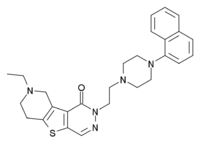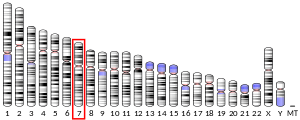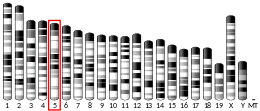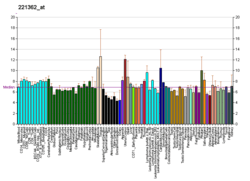5-HT5A receptor
5-Hydroxytryptamine (serotonin) receptor 5A, also known as HTR5A, is a protein that in humans is encoded by the HTR5A gene.[5][6]
Function
The gene described in this record is a member of 5-hydroxytryptamine receptor family and encodes a multi-pass membrane protein that functions as a receptor for 5-hydroxytryptamine and couples to G proteins, negatively influencing cAMP levels via Gi and Go.[7] This protein has been shown to function in part through the regulation of intracellular Ca2+ mobilization.[5] The 5-HT5A receptor has been shown to be functional in a native expression system.[8]
Rodents have been shown to possess two functional 5-HT5 receptor subtypes, 5-HT5A and 5-HT5B,[9] however while humans possess a gene coding for the 5-HT5B subtype, its coding sequence is interrupted by stop codons, making the gene non-functional, and so only the 5-HT5A subtype is expressed in human brain.[10]
It also appears to serve as a presynaptic serotonin autoreceptor.[11]
Clinical significance
The neurotransmitter serotonin (5-hydroxytryptamine, 5-HT) has been implicated in a wide range of psychiatric conditions and also has vasoconstrictive and vasodilatory effects.[5]
Selective Ligands
Few highly selective ligands are commercially available for the 5-HT5A receptor. When selective activation of this receptor is desired in scientific research, the non-selective serotonin receptor agonist 5-Carboxamidotryptamine can be used in conjunction with selective antagonists for its other targets (principally 5-HT1A, 5-HT1B, 5-HT1D, and 5-HT7). Research in this area is ongoing.[12][13]
Agonists
- LSD:(+)-lysergic acid, [14]
- Valerenic acid, a component of valerian, has been shown to act as a 5HT5A partial agonist.[15]
- Olanzapine, an atypical antipsychotic.[16]
- Another ligand that has been recently disclosed is shown below, claimed be a selective 5-HT5A agonist with Ki = 124 nM.[17]

Antagonists
- ASP-5736[18][19]
- AS-2030680[18]
- AS-2674723[18]
- Latrepirdine (non-selective)[20]
- Risperidone (non-selective), moderate 206nM affinity.
- SB-699,551
See also
References
- GRCh38: Ensembl release 89: ENSG00000157219 - Ensembl, May 2017
- GRCm38: Ensembl release 89: ENSMUSG00000039106 - Ensembl, May 2017
- "Human PubMed Reference:". National Center for Biotechnology Information, U.S. National Library of Medicine.
- "Mouse PubMed Reference:". National Center for Biotechnology Information, U.S. National Library of Medicine.
- "Entrez Gene: HTR5A 5-hydroxytryptamine (serotonin) receptor 5A".
- Rees S, den Daas I, Foord S, Goodson S, Bull D, Kilpatrick G, Lee M (Dec 1994). "Cloning and characterisation of the human 5-HT5A serotonin receptor". FEBS Letters. 355 (3): 242–6. doi:10.1016/0014-5793(94)01209-1. PMID 7988681.
- Francken BJ, Jurzak M, Vanhauwe JF, Luyten WH, Leysen JE (Nov 1998). "The human 5-ht5A receptor couples to Gi/Go proteins and inhibits adenylate cyclase in HEK 293 cells". European Journal of Pharmacology. 361 (2–3): 299–309. doi:10.1016/S0014-2999(98)00744-4. PMID 9865521.
- Goodfellow NM, Bailey CD, Lambe EK (Apr 2012). "The native serotonin 5-HT(5A) receptor: electrophysiological characterization in rodent cortex and 5-HT(1A)-mediated compensatory plasticity in the knock-out mouse". The Journal of Neuroscience. 32 (17): 5804–9. doi:10.1523/JNEUROSCI.4849-11.2012. PMC 4644074. PMID 22539842.
- Matthes H, Boschert U, Amlaiky N, Grailhe R, Plassat JL, Muscatelli F, Mattei MG, Hen R (Mar 1993). "Mouse 5-hydroxytryptamine5A and 5-hydroxytryptamine5B receptors define a new family of serotonin receptors: cloning, functional expression, and chromosomal localization". Molecular Pharmacology. 43 (3): 313–9. PMID 8450829.
- Nelson DL (Feb 2004). "5-HT5 receptors". Current Drug Targets. CNS and Neurological Disorders. 3 (1): 53–8. doi:10.2174/1568007043482606. PMID 14965244.
- {{cite journal | vauthors = Thomas DR, Soffin EM, Roberts C, Kew JN, de la Flor RM, Dawson LA, Fry VA, Coggon SA, Faedo S, Hayes PD, Corbett DF, Davies CH, Hagan JJ | title = SB-699551-A (3-cyclopentyl-N-[2-(dimethylamino)ethyl]-N-[(4'-{[(2-phenylethyl)amino]methyl}-4-biphenylyl)methyl]propanamide dihydrochloride), a novel 5-ht5A receptor-selective antagonist, enhances 5-HT neuronal function: Evidence for an autoreceptor role for the 5-ht5A receptor in guinea pig brain | journal = Neuropharmacology | volume = 51 | issue = 3 | pages = 566–77 | date = Sep 2006 | pmid = 16846620 | doi = 10.1016/j.neuropharm.2006.04.019 }}
- Wesołowska A (2002). "In the search for selective ligands of 5-HT5, 5-HT6 and 5-HT7 serotonin receptors" (PDF). Polish Journal of Pharmacology. 54 (4): 327–41. PMID 12523486.
- Peters JU, Lübbers T, Alanine A, Kolczewski S, Blasco F, Steward L (Jan 2008). "Cyclic guanidines as dual 5-HT5A/5-HT7 receptor ligands: optimising brain penetration". Bioorganic & Medicinal Chemistry Letters. 18 (1): 262–6. doi:10.1016/j.bmcl.2007.10.078. PMID 18023344.
- The RBI Handbook of Receptor Classification and Signal Transduction, page 114 (1995)ISBN 0-9640548-1-7
- Dietz BM, Mahady GB, Pauli GF, Farnsworth NR (Aug 2005). "Valerian extract and valerenic acid are partial agonists of the 5-HT5a receptor in vitro". Brain Research. Molecular Brain Research. 138 (2): 191–7. doi:10.1016/j.molbrainres.2005.04.009. PMC 5805132. PMID 15921820.
- Roth BL, Driscol J. "PDSP Ki Database". Psychoactive Drug Screening Program (PDSP). University of North Carolina at Chapel Hill and the United States National Institute of Mental Health. Retrieved 14 August 2017.
- US 6750221, "Use of 5-HT5-ligands in the treatment of neurodegenerative and neuropsychiatric disturbances", published 2004-06-15
- Yamazaki M, Okabe M, Yamamoto N, Yarimizu J, Harada K (2015). "Novel 5-HT5A receptor antagonists ameliorate scopolamine-induced working memory deficit in mice and reference memory impairment in aged rats". J. Pharmacol. Sci. 127 (3): 362–9. doi:10.1016/j.jphs.2015.02.006. PMID 25837935.
- Yamazaki M, Harada K, Yamamoto N, Yarimizu J, Okabe M, Shimada T, Ni K, Matsuoka N (2014). "ASP5736, a novel 5-HT5A receptor antagonist, ameliorates positive symptoms and cognitive impairment in animal models of schizophrenia". Eur Neuropsychopharmacol. 24 (10): 1698–708. doi:10.1016/j.euroneuro.2014.07.009. PMID 25108314.
- Wu J, Li Q, Bezprozvanny I (2008). "Evaluation of Dimebon in cellular model of Huntington's disease". Molecular Neurodegeneration. 3 (1): 15. doi:10.1186/1750-1326-3-15. PMC 2577671. PMID 18939977.
Further reading
- Raymond JR, Mukhin YV, Gelasco A, Turner J, Collinsworth G, Gettys TW, Grewal JS, Garnovskaya MN (2002). "Multiplicity of mechanisms of serotonin receptor signal transduction". Pharmacology & Therapeutics. 92 (2–3): 179–212. doi:10.1016/S0163-7258(01)00169-3. PMID 11916537.
- Thomas DR (Sep 2006). "5-ht5A receptors as a therapeutic target". Pharmacology & Therapeutics. 111 (3): 707–14. doi:10.1016/j.pharmthera.2005.12.006. PMID 16516972.
- Rees S, den Daas I, Foord S, Goodson S, Bull D, Kilpatrick G, Lee M (Dec 1994). "Cloning and characterisation of the human 5-HT5A serotonin receptor". FEBS Letters. 355 (3): 242–6. doi:10.1016/0014-5793(94)01209-1. PMID 7988681.
- Schanen NC, Scherer SW, Tsui LC, Francke U (1997). "Assignment of the 5-hydroxytryptamine (serotonin) receptor 5A gene (HTR5A) to human chromosome band 7q36.1". Cytogenetics and Cell Genetics. 72 (2–3): 187–8. doi:10.1159/000134184. hdl:10722/42533. PMID 8978771.
- Sanger Centre, The; Washington University Genome Sequencing Cente, The (Nov 1998). "Toward a complete human genome sequence". Genome Research. 8 (11): 1097–108. doi:10.1101/gr.8.11.1097. PMID 9847074.
- Francken BJ, Josson K, Lijnen P, Jurzak M, Luyten WH, Leysen JE (May 2000). "Human 5-hydroxytryptamine(5A) receptors activate coexpressed G(i) and G(o) proteins in Spodoptera frugiperda 9 cells". Molecular Pharmacology. 57 (5): 1034–44. PMID 10779389.
- Marazziti D, Ori M, Nardini M, Rossi A, Nardi I, Cassano GB (2001). "mRNA expression of serotonin receptors of type 2C and 5A in human resting lymphocytes". Neuropsychobiology. 43 (3): 123–6. doi:10.1159/000054878. PMID 11287788.
- Iwata N, Ozaki N, Inada T, Goldman D (Mar 2001). "Association of a 5-HT(5A) receptor polymorphism, Pro15Ser, to schizophrenia". Molecular Psychiatry. 6 (2): 217–9. doi:10.1038/sj.mp.4000829. PMID 11317225.
- Grailhe R, Grabtree GW, Hen R (Apr 2001). "Human 5-HT(5) receptors: the 5-HT(5A) receptor is functional but the 5-HT(5B) receptor was lost during mammalian evolution". European Journal of Pharmacology. 418 (3): 157–67. doi:10.1016/S0014-2999(01)00933-5. PMID 11343685.
- Noda M, Yasuda S, Okada M, Higashida H, Shimada A, Iwata N, Ozaki N, Nishikawa K, Shirasawa S, Uchida M, Aoki S, Wada K (Jan 2003). "Recombinant human serotonin 5A receptors stably expressed in C6 glioma cells couple to multiple signal transduction pathways". Journal of Neurochemistry. 84 (2): 222–32. doi:10.1046/j.1471-4159.2003.01518.x. PMID 12558985.
- Khorana N, Smith C, Herrick-Davis K, Purohit A, Teitler M, Grella B, Dukat M, Glennon RA (Aug 2003). "Binding of tetrahydrocarboline derivatives at human 5-HT5A receptors". Journal of Medicinal Chemistry. 46 (18): 3930–7. doi:10.1021/jm030080s. PMID 12930153.
- Dietz BM, Mahady GB, Pauli GF, Farnsworth NR (Aug 2005). "Valerian extract and valerenic acid are partial agonists of the 5-HT5a receptor in vitro". Brain Research. Molecular Brain Research. 138 (2): 191–7. doi:10.1016/j.molbrainres.2005.04.009. PMC 5805132. PMID 15921820.
External links
- "5-ht5a". IUPHAR Database of Receptors and Ion Channels. International Union of Basic and Clinical Pharmacology.
- Human HTR5A genome location and HTR5A gene details page in the UCSC Genome Browser.
This article incorporates text from the United States National Library of Medicine, which is in the public domain.




